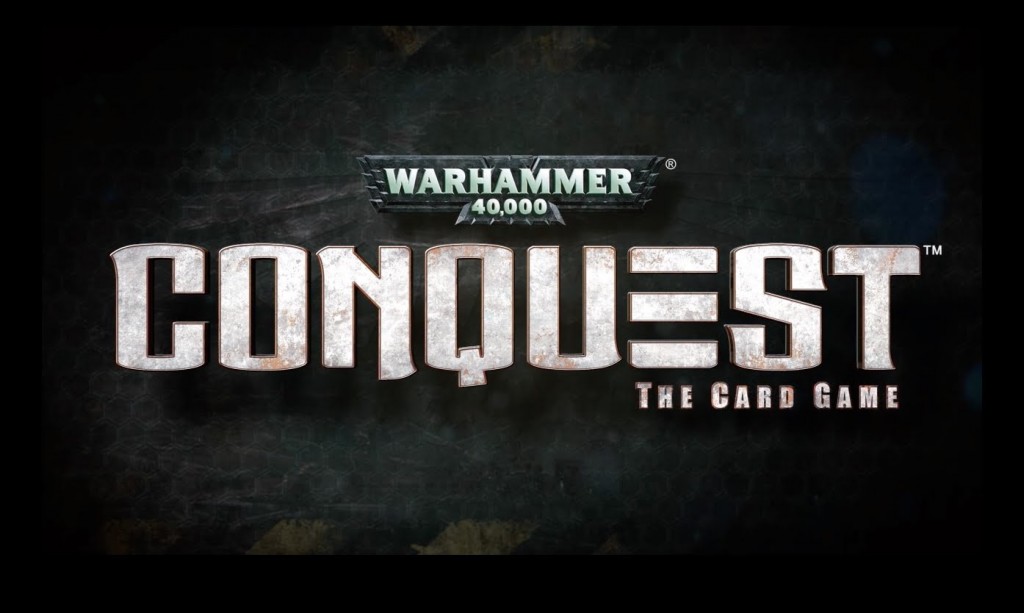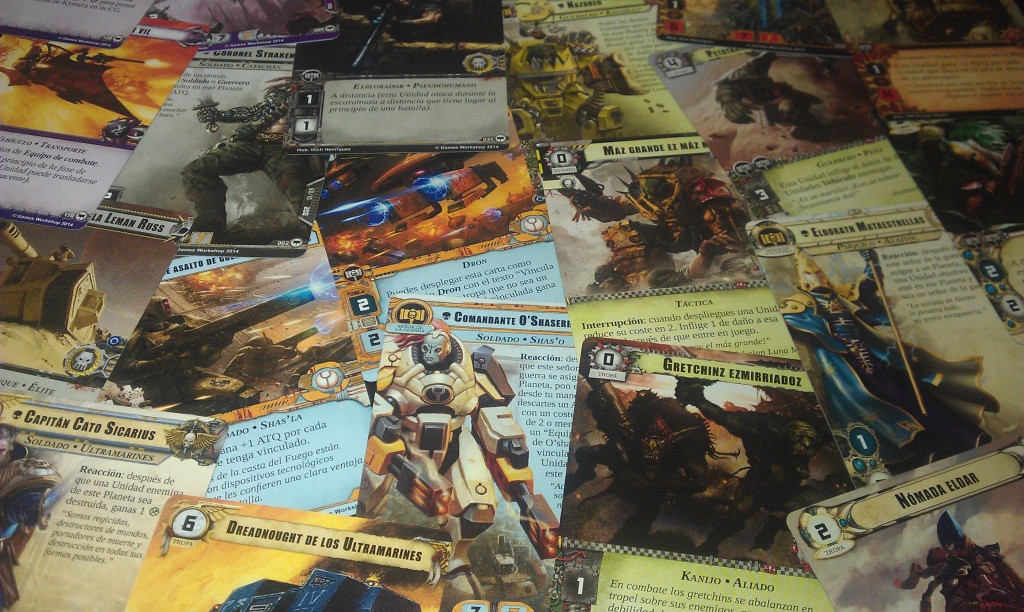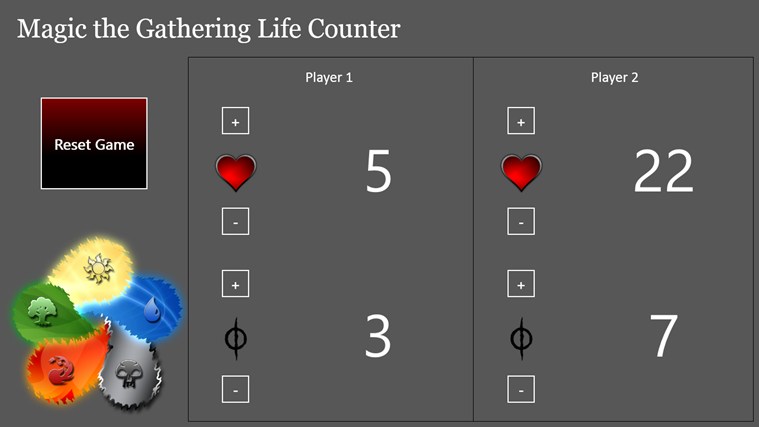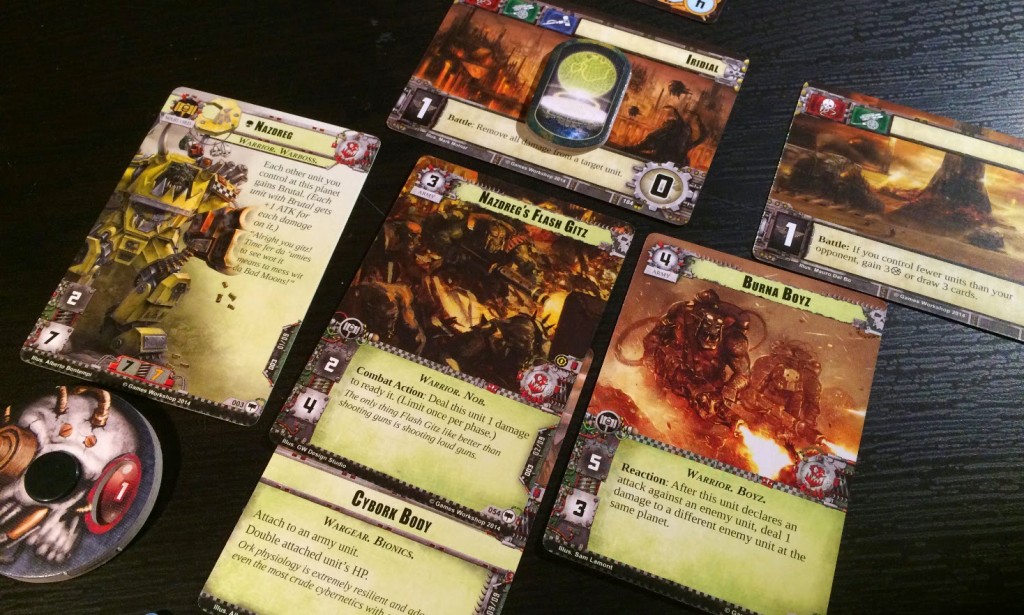I wrote this article about a year ago when Conquest came out. Next week I will write a follow up and reflection on the current state of the game, but enjoy this article for now!
I have been listening to lots of podcasts about gaming, as I do with a lot of my time, and have noticed an interesting theme with a certain podcast about a game I am becoming quite fond of, Warhammer 40,000: Conquest is the game I am speaking of in this case. Hold off judging this game because it has the words, “Warhammer” and “40,000” in the title. Yes this IP is made by Games Workshop, lately notorious for their expensive models and frequent pricey rules updates, but that is not all you should see when you look at a title. Fantasy Flight Games is the publisher of this game, created by Eric Lang, designer of such great games as Qurriors, Chaos in the Old World and 24 more pages of games on BGG. Okay, so back to the interesting part of the podcast I listened to about this game. So, I am listening to it and the caster keeps talking about battles and the effectiveness of units on planets where battle is taking place. Wait, now that I think of it, I may need to do a quick over view of the game to get everyone reading this up to speed.
To start off this is a living card game, a game where you you build your deck before hand then play against other people who also have decks. Like other living card games, this game has a very unique feel to it. You start off choosing a warlord card. the core set comes with 7 factions (Imperial Guard, Space Marines, Tau, Eldar, Dark Eldar, Chaos, and Orks) and starting decks for each of them. Once decks are constructed for the planets of the system you will fight, it will be determined by choosing 7 out of the 10 provided and revealing 5 of them.
Each player starts by drawing cards from their deck and gaining resources from the resource pool equal to the values on their warlord’s card, typically 7 and 7 with the core set warlords. the first round brings with it a Deployment Phase, where each player takes turns performing actions. These usually consist of playing cards from you hand on planets or using events or playing support cards at your HQ (the area where your warlord starts and is not associated with any planets) or playing attachments in your army units. After each player passes in sequence the Deployment Phase ends and we move to the Command Phase.
The eloquence of this game comes through in the Command Phase. Each commander secretly chooses a plant to send their warlord to out the 5 (and there is never more than 5) visible. This is a huge part of the game as I will explain later. After warlords have been committed, each player resolves command struggles looking at each planet from the first to the last. This is done by checking a few things.
- Is there one or more ready warlord at the planet?
- Who has the most command icons on ready units at the planet?
Once these have been checked players gain resources and cards equal to the planet’s value and the Command Phase ends. Next up is the Combat phase.
In this phase battles are fought at the first planet and any planet containing a warlord. The first planet is scored based on whoever has units on it after the battle is resolved and battle ability of any planet where a battle takes place are also resolved. This is also a very elegant part of this game, not the battles themselves necessarily, but choosing which battle abilities to fight for. After all battles have been resolved we complete the Combat Phase and move to the Headquarters Phase.
In this final phase a new planet is revealed and the first planet is now changed to the next planet in line, players draw two cards and gain 4 resources and all exhausted units ready. Finally players check for one of the two victory conditions. If one player has scored any number of planets that show three of the same symbol they have won the game. the other condition for victory is killing someones warlord, which is an instant victory upon that even happening.
*Phew* Okay so now that the layout of the game has been set, let’s get back to the interesting theme that I noticed in the podcast. The host seemed to be only judging units on their effectiveness in battle. I do think this is personally the best way to view the cards in this game and I’ll explain why using two points.
- The game is not your traditional, “I have a set amount of life you must remove” game.
- The crux of the game is in utilizing resources and effectively balancing tactical and strategic decisions.
The Game is not your traditional, “I have a set amount of life you must remove” game.
While some may think that since the warlord has a set amount of life and the warlord dying is a win condition the easiest way to win is by killing the warlord (or as I am going to refer to it as assassination). This is not true for frequent players of the game. when a warlord kill happens it happens for two reasons, usually. The first is that you have made a mistake about where to send your warlord. The second is you made a mistake earlier about where you positioned your warlord and forgot about a formidable event. This game is not about sending your warlord places to simply fight and kill. Okay well maybe for the Orks. but the beauty of this game is not in the fighting of units, it is in the second point…
The crux of the game is in utilizing resources and effectively balancing tactical and strategic decisions.
The warlord is a huge force for stopping your opponent from doing this. If you commit your warlord to the only planet that your opponent is getting resources from in the command struggle you have effectively hobbled him for the next turn. Managing cards and resources is a huge part of this game. Cards are not always just dead in your hand in this game. Some cards can be used as shields, events can be played mid combat to change the tide of battle and event cards can make a single unit entirely useless at doing anything.
On a very basic level this game is about fighting, because what war is not? However, where this game shines is that it not only gives you the feel for battle, but it also lets you manage the campaign of a war. Mismanaging resource utilization can be the nail in the coffin for even the most psychical or technologically advanced army. This game thrives in the art of managing your resources. And no, not just the tokens but each and every card and play, can mean the difference between losing and winning. Thinking of this game as getting the bigger, cheaper units as better is not an apt strategy and is a remnant from more popular card games that use a life source as way to judge victory.






Pingback: Boxed Culture: War is in the Cards – Now (Needs Edit And Post) | Aeither.net